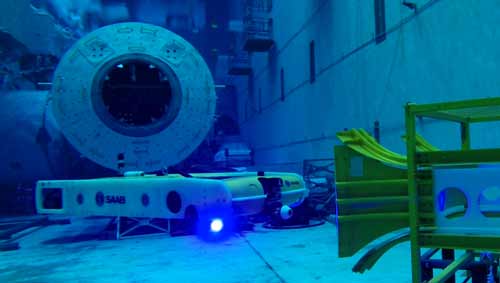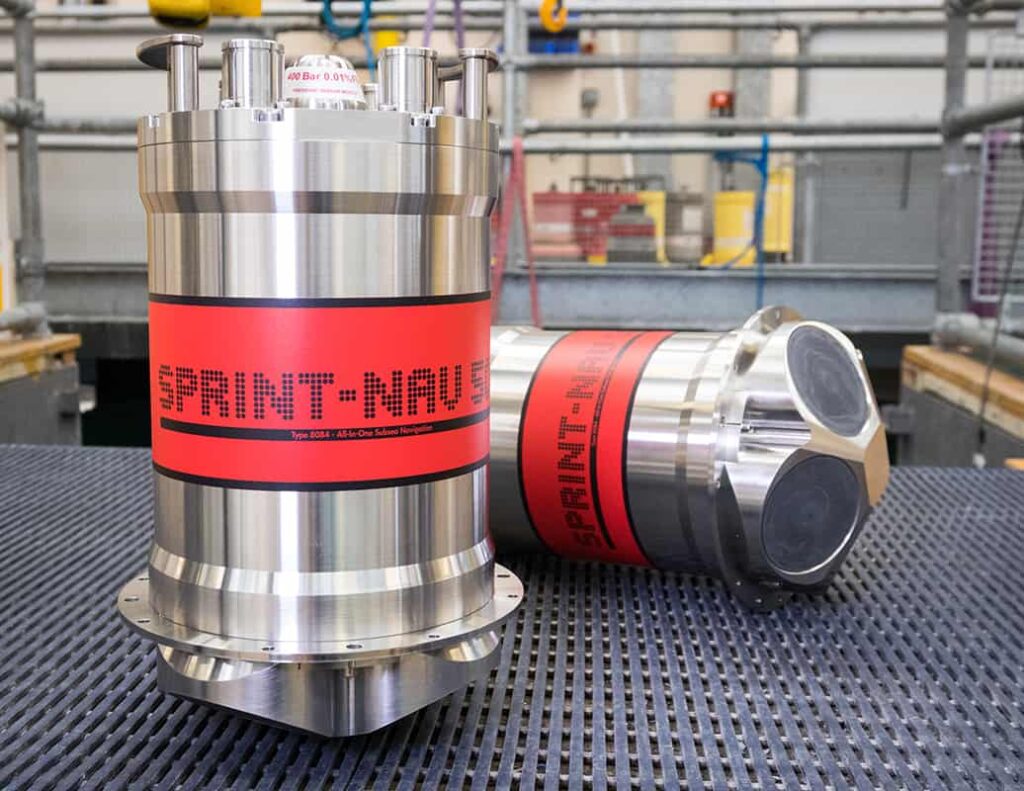Leading engineering consultancy BMT and subsea technology company Sonardyne International Ltd. have signed an agreement to provide advanced integrated marine integrity monitoring solutions to the oil and gas industry.
The official Teaming Agreement between BMT and Sonardyne, announced today [Thursday, 27 September] at the Rio Oil & Gas exhibition and conference in Brazil, will allow the two companies to collaboratively provide smarter and more efficient through-life solutions for monitoring and managing critical subsea assets, including drilling and production risers, moorings and wellheads.
By jointly offering BMT’s monitoring and analysis capabilities with Sonardyne’s expertise in autonomous, long-endurance data collection and through-water telemetry, clients globally will benefit from a wider range of options to bring more subsea integrity data to their desktops faster, making it easier for them to make safety critical decisions at the right time.
BMT and Sonardyne already have a strong working relationship and see this agreement as an opportunity to offer a further step-change in the solutions provided to customers. BMT will bring 30 years of marine instrumentation design experience and extensive integration expertise to the working arrangement, while Sonardyne will provide access to subsea data logging and communication technology including its SMART low-power subsea sensors.
Stephen Auld, Global Business Manager, Subsea Asset Monitoring, Sonardyne, says, “BMT are market leaders in marine instrumentation and riser monitoring technology and, having worked with them for a number of years now, we see this agreement as a way to transform what we can offer to the industry by working more closely together.”
[blockquote author=” Rob Barker, Regional General Manager at BMT”]”Sonardyne are a world leader in the development of through water positioning and communication technology and these are integral components for our subsea integrity monitoring systems. We are delighted to have formalised a collaborative agreement with them.”[/blockquote]
The two companies are already working on proposals for major operators globally, which would offer significant cost reductions on existing systems, with longer periods between maintenance.
Sonardyne and BMT will be present at Rio Oil & Gas in Brazil this week (September 24-27). Sonardyne is exhibiting in Hall 4, stand Q44.
Underwater target tracking technology from Houston-based Sonardyne Inc., has been chosen by the US Naval Surface Warfare Center (NSWC), Carderock Division for use at its South Florida Ocean Measurement Facility (SFOMF).
Located in Maryland, Carderock Division is the US Navy’s research, engineering, modelling, and test centre for surface and undersea technologies. It is the largest, most comprehensive establishment of its kind in the world. Thanks to its proximity to the Gulf Stream, Carderock’s SFOMF provides a demanding open ocean test environment for subsea systems and unmanned underwater vehicles (UUVs) in development for both the Navy and wider maritime industry.
To support this work, Carderock Division has ordered Sonardyne’s high accuracy Ranger 2 Ultra Short Baseline (USBL) acoustic tracking system, complete with a GyroUSBL transceiver, Nano and Wideband Sub-Mini 6 Plus (WSM 6+) transponders.
Mobilized aboard vessels-of-opportunity, the Ranger 2 system will enable operators to track the precise underwater position of any subsea system or UUV that comes through the SFOMF for testing. The system offers the capability of tracking systems in both shallow and deep water, near the surface and over very long ranges. By purchasing both Nano and WSM 6+ transponders, all sizes of vehicle can be accommodated, from man-portable models through to extra-large (XLUUV) designs.
Dan Zatezalo, Technical Sales Manager at Sonardyne Inc., said, “This system will more than meet Navy expectations. Our Ranger 2 GyroUSBL is a survey grade acoustic positioning system with built-in attitude and heading sensors, which makes moving it from vessel to vessel easy, with no new calibration required. Used alongside Nano, our smallest ever, rechargeable acoustic transponder, and WSM 6+ transponders, which both support our secure Wideband 2 signal protocols, the NSWC has a high-performance and time-saving system for its operations at Maryland. This sale also further embeds our commercial-off-the-shelf capabilities, field-proven within the US offshore energy and science sectors, into the North American defence market.”
The SFOMF has housed an active, continuously operating Navy range for more than 50 years. Its main mission is to perform electromagnetic signature tests of Navy assets, using multiple fixed, in-water electromagnetic and acoustic measurement sites. The facility also tests and evaluates mine detection, countermeasures and mine response; performs acoustic measurements; and acquires radar cross section and infrared signatures.
Author: Ioseba Tena – Global Business Manager – Marine Robotic Systems
Autonomous underwater vehicles (AUVs), subsea robotics and remote operated vehicles (ROVs) will come under the spotlight in Aberdeen tomorrow for Subsea UK’s Underwater Vehicles Conference (UVC). This is an industry that has experienced a painful downturn, one which has also encouraged innovators to seek out new solutions to optimise their performance.
 There is a new generation of ROVs and hybrid- field resident AUVs and they will have many different challenges: inspection, intervention and mapping, with less support infrastructure, over wider areas and/or at higher speeds.
There is a new generation of ROVs and hybrid- field resident AUVs and they will have many different challenges: inspection, intervention and mapping, with less support infrastructure, over wider areas and/or at higher speeds.
At the core of all these missions is a requirement for vehicles to be able to navigate reliably in all conditions and to a given accuracy level. To date, navigation has been the sum of its parts: a Doppler velocity log (DVL) tells the vehicle its speed and altitude from the seafloor; a depth sensor its depth; the gyro its heading; the USBL/LBL (Ultrashort BaseLine/Long BaseLine) a latitude and longitude coordinate. An Inertial Navigation System (INS) may also be used to improve short-term accuracy, precision and reliability. The vehicle must then integrate all these inputs for vehicle guidance and navigation.
However, most of these instruments are designed only for standalone operation and so improvements in accuracy and reliability that can be gained with tight integration are not realised. In addition, all these separate instruments must be calibrated or aligned to each other; a task that can be complex and error-prone in the offshore environment. Timing between the instruments is another challenge.
 We have developed a hybrid navigator, SPRINT-Nav, which tightly integrates all the raw sensor data at a low level to provide unprecedented improvement in self-contained or ‘dead-reckoning’ navigation accuracy and reliability.
We have developed a hybrid navigator, SPRINT-Nav, which tightly integrates all the raw sensor data at a low level to provide unprecedented improvement in self-contained or ‘dead-reckoning’ navigation accuracy and reliability.
It enables significant efficiencies and cost savings for both current underwater vehicles and the emerging new generation resident vehicles. Many missions, such as pre-lay survey and inspection, can now be performed without any assistance from surface vessels or subsea infrastructure, achieving accuracies two to five (and more) times better than separately integrated instruments at the same cost. Hybrid navigation also supports a step-change in seabed relative station keeping, typically achieving <1 metre error over 24 hours. Importantly, for resident vehicles, this level of performance can be achieved within 10 minutes of start-up, even in a static seabed dock – no special alignment trajectories need to be flown, saving previous precious operational time and on-board battery power.
Where extremely high accuracy is required, SPRINT-Nav can be combined with seabed acoustics to provide centimetric levels of accuracy, enabling the most demanding dynamic mapping and imaging missions such as subsea metrology.
Our Engineering Manager Malik Chibah will be explaining mission specific performance and how we achieve it in more depth at 1.50pm during UVC, which is being held at Aberdeen Exhibition and Conference Centre. We’ll also be suggesting how this technology can be applied to across other industries such as renewables, aquaculture and defence.
Come talk to us at the conference and we’ll discuss the right fit hybrid navigation for your vehicle and missions or contact us here.